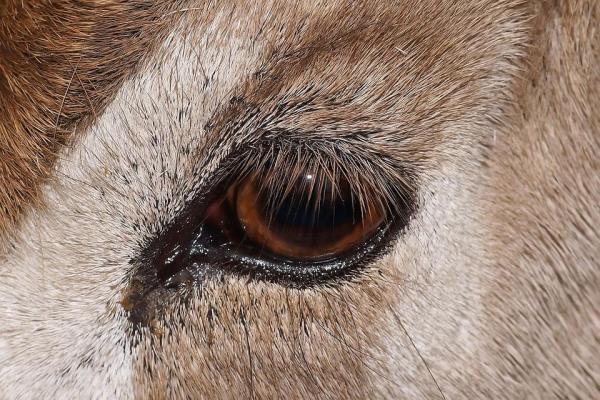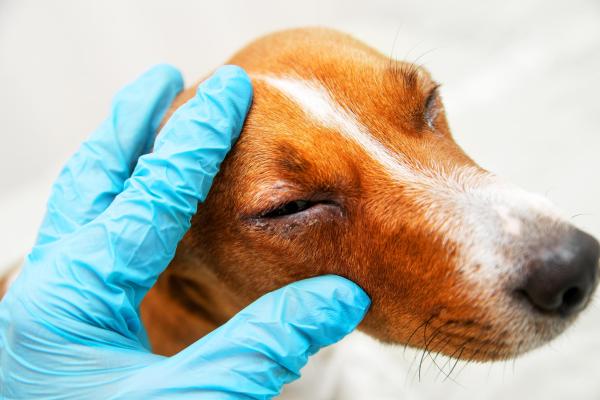
Eyelashes are the small hairs that grow on the edge of the eyelid and have a protective function for the eye. They protect it from external influences such as wind, foreign bodies, dust, etc. and promote the moisture of the eye. When the eyelashes grow abnormally toward the cornea, they can cause a corneal disease known as distichiasis. Distichiasis is one of the most common congenital abnormalities of the eyelids in dogs. It is an abnormal growth of the eyelashes from the meibomian glands that can be directed toward the cornea and cause eye lesions with associated symptoms.
The following AnimalWised article explains what distichiasis is in dogs, the symptoms, treatment, and causes of this eye condition.
What is distichiasis in dogs?
Distichiasis is the appearance of an eyelash in an abnormal location. They may emerge from the lid margin or through the pores of the meibomian glands. These are the glands located at the edge of the eyelid that contribute to the formation of tears. Sometimes you can see the eyelashes with the naked eye, although some of them can only be seen with a magnifying glass.
The hairs or eyelashes associated with distichiasis may occur singly or in groups and may be present on the upper, lower, or both eyelids. Moreover, it may affect one or both eyes, i.e., we may find unilateral distichiasis or bilateral distichiasis in dogs.
Distichiasis is a congenital disorder (i.e., it is present from birth) that can also be inherited . Among dogs, there are certain breeds that are particularly prone to this anomaly, such as:
- American Cocker Spaniel
- Yorkshire Terrier
- Shih Tzu
- English bulldog
- Boxer
- Pekingese
- Cavalier King Charles Spaniel
- Lhasa Apso
- Dachshund
- Shetland Sheepdog
- Golden Retriever
- Chesapeake Retriever
- Bulldog
- Boston Terrier
- Pug
You may also be interested in this other article, where we explain how to properly clean your dog's eyes.

Symptoms of distichiasis in dogs
Symptoms associated with distichiasis vary widely and depend on the number of cilia present, their stiffness, and their orientation.
In many cases, distichiasis is asymptomatic (without symptoms) and is nothing more than an incidental finding discovered during an ophthalmologic examination for some other reason. This is usually the case when only a few eyelashes are present, they are not very rigid, and they are directed outward (like normal eyelashes).
However, when the eyelashes are very rigid or directed toward the cornea, it is normal for them to cause eye lesions that lead to appropriate symptoms. In these cases, it is common to observe symptoms such as:
- Excessive lacrimation
- Corneal lesions such as Keratitis, ulcers and corneal pigmentation
- Chronic conjunctivitis
- Irritation
- Constant rubbing
- Redness or inflammation of the eye
Read on to learn more about conjunctivitis in dogs, its signs and treatment.

Causes of distichiasis in dogs
As we have already mentioned, distichiasis in dogs is a congenital disease. Neither the mode of inheritance nor the genes involved have been studied in detail and are therefore unknown.
In any case, the fact that it is a hereditary disease must be taken into account when breeding dogs, especially if they are predisposed breeds. Remember that one of the principles of responsible breeding is to ensure optimal health status of breeders, especially with regard to hereditary diseases.
Diagnosis of distichiasis in dogs
The diagnosis of distichisis is simple. A simple ophthalmologic examination is sufficient to determine the presence of these abnormal eyelashes. In some cases, fluorescein staining of the cornea and evaluation of the degree of tear production in the eyes is necessary to assess the extent of concomitant corneal injury and to rule out other causes of the dog's clinical signs.
Some dogs require topical anesthetics or sedatives to relieve severe discomfort and allow a thorough examination of the tissue around the eye.
Treatment for distichiasis in dogs
Treatment of distichiasis in dogs depends on the symptoms it causes. If dogs with abnormal eyelashes have no accompanying symptoms, specific treatment is not needed. However, if the eyelashes cause eye injuries, it is essential to remove them to avoid complications.
In the past, a number of surgical techniques were developed to remove the follicles from which the cilia of distichiasis originate. These techniques included excision of the eyelids, partial ablation of the tarsi, or plastics aimed at changing the direction of the cilia. However, these methods resulted in severe anatomic and functional alterations of the eyelid, so they were abandoned and replaced by new therapeutic techniques.
Currently, the most commonly used techniques for the treatment of distichiasis in dogs are:
- Cryodepilation: it is one of the most commonly used techniques. It consists in the application of nitrous oxide or liquid nitrogen to the site where the ectopic hair follicle is suspected. The percentage of recurrence or reappearance is not very high with this technique, and when new hairs appear, they are usually finer and less problematic. However, it must be taken into account that this treatment causes inflammation of the eyelids, so treatment with anti-inflammatory agents, both systemic and local, is required.
- Electroepilation: in this case, hair removal is performed with direct current. The technique consists of inserting the needle-shaped cathode electrode into the eyelid and administering a current of 2-5 mA until the hair is detached. Recurrences often occur with this method, so the procedure often needs to be repeated.
- Photoepilation: consists of the application of a monochromatic beam of light that interacts with the hair and causes the destruction of the hair bulb. However, several sessions are required to achieve an effect. The main problem is that the effectiveness of the laser depends on the pigmentation of the hair. Since the laser only affects areas with a lot of melanin, it is usually not effective on very light hair.
- Electrolysis: this technique is widely used in human medicine, but is new in veterinary medicine. It consists in the application of a direct current through an acupuncture needle inserted into each hair bulb. This induces an electrochemical reaction in the follicle, facilitating its degeneration and later its resorption.
- Manual hair removal: this technique is the cheapest and easiest, but the percentage of recurrence or reappearance is very high. Moreover, in case of recurrence, the new hairs tend to grow shorter and be less flexible, so they tend to be more distichiasis.
If left untreated, distichia causing clinical signs will continue to cause irritation and pain, and the irritation can lead to severe corneal ulceration and secondary bacterial infections. These can lead to blindness or loss of the eye.
This article is purely informative. AnimalWised does not have the authority to prescribe any veterinary treatment or create a diagnosis. We invite you to take your pet to the veterinarian if they are suffering from any condition or pain.
If you want to read similar articles to Distichiasis - Extra Eyelashes in Dogs, we recommend you visit our Eye problems category.
- Alonso, A.; Sanchez, J.; Serrantes, AE; Garcia, MB; Bobis, D.; Sanchez, JM (2019). canine distichiasis. Treatment with the EPI technique. Veterinary broadcast consultation; 27(261):43-49
- Rico, S.; Jaenes, JC; Cartagena, JC (2020) Eyelid diseases in dogs and cats . Argos, 221:38-43